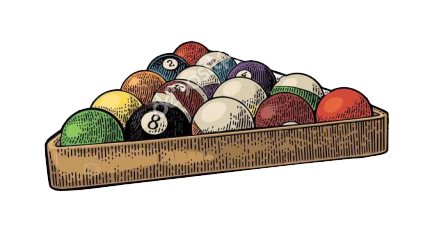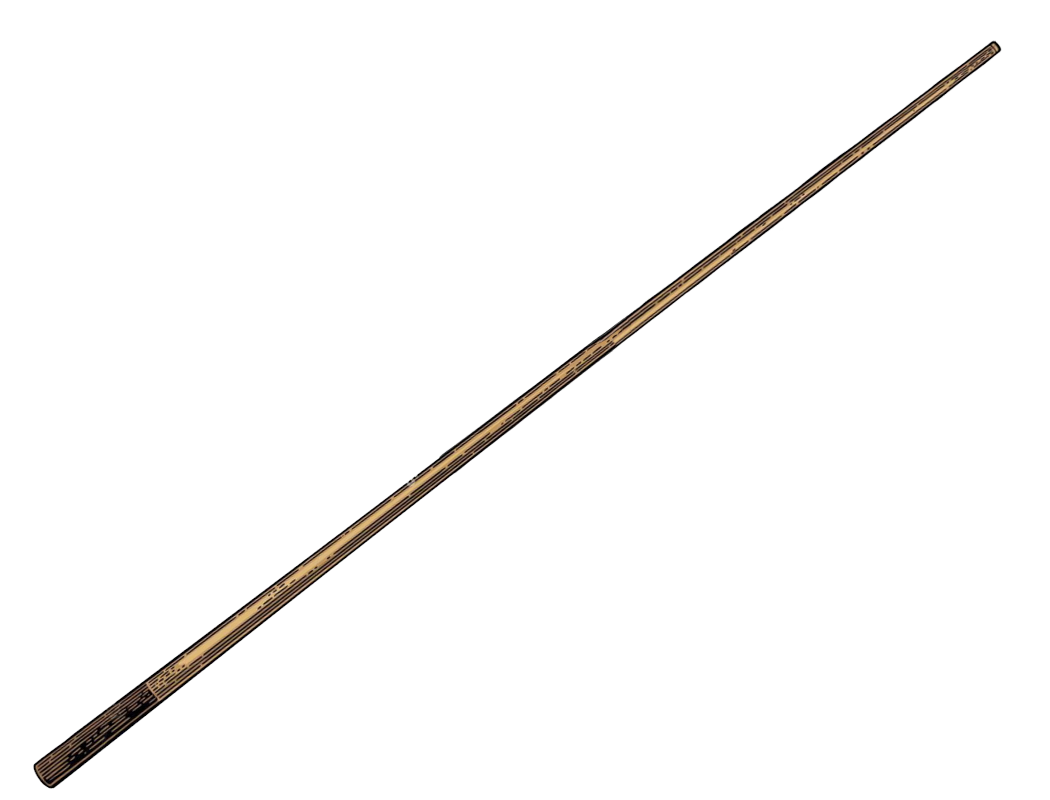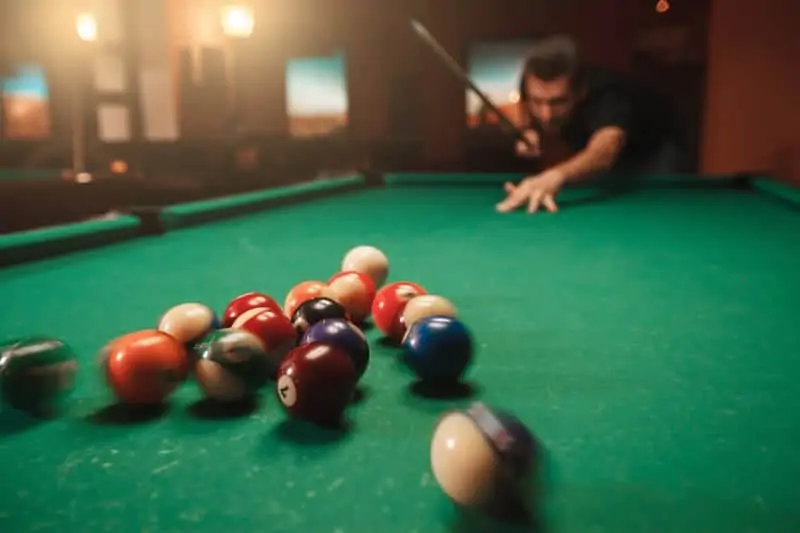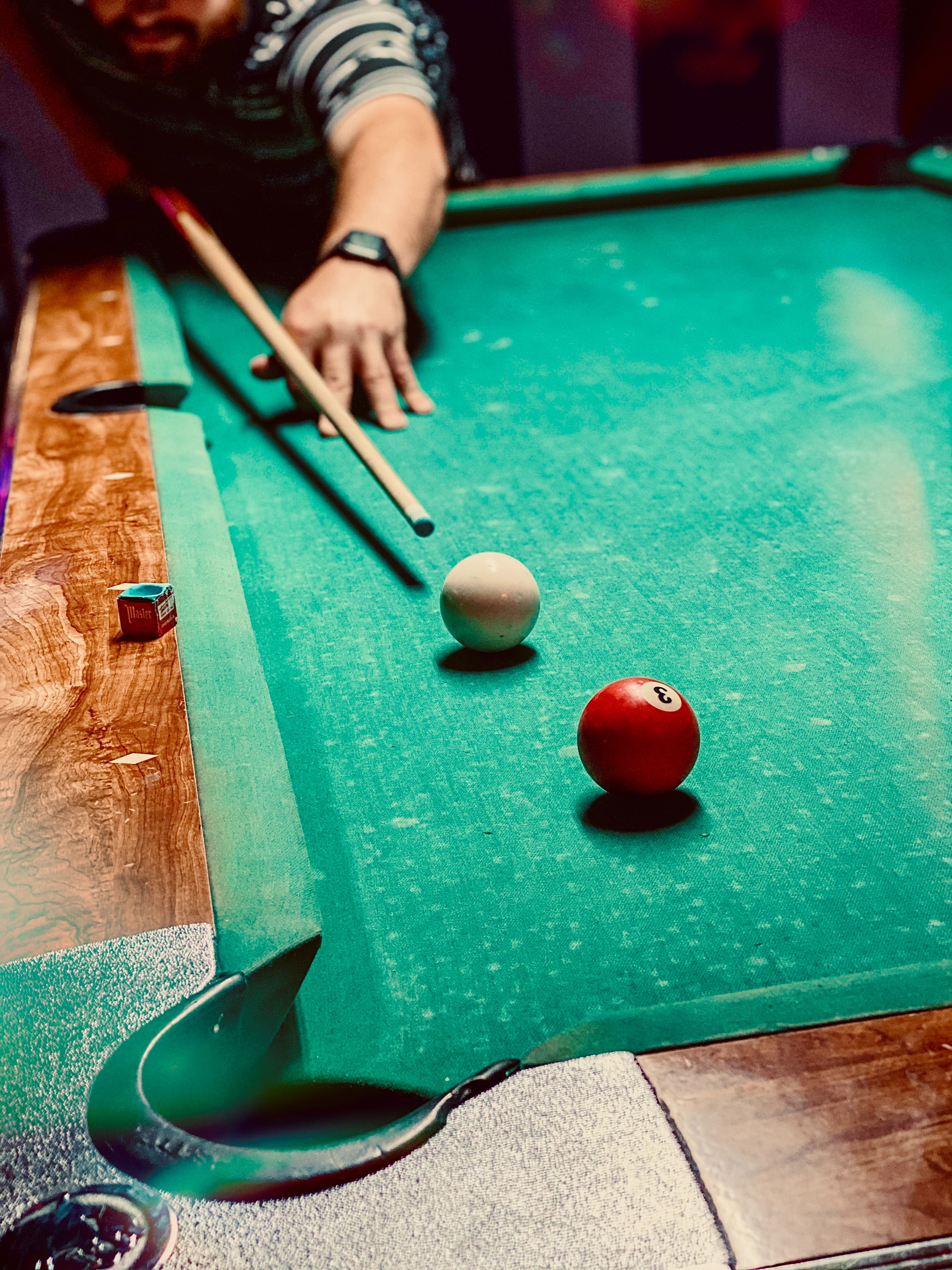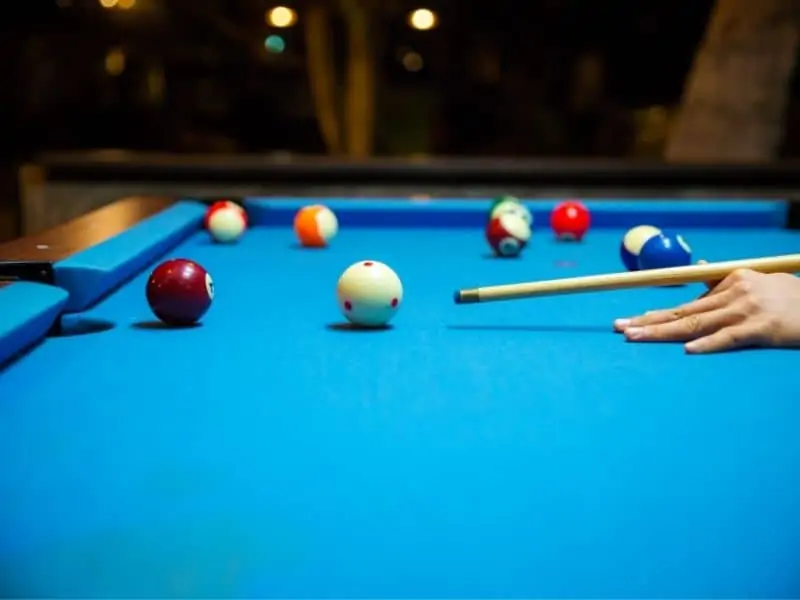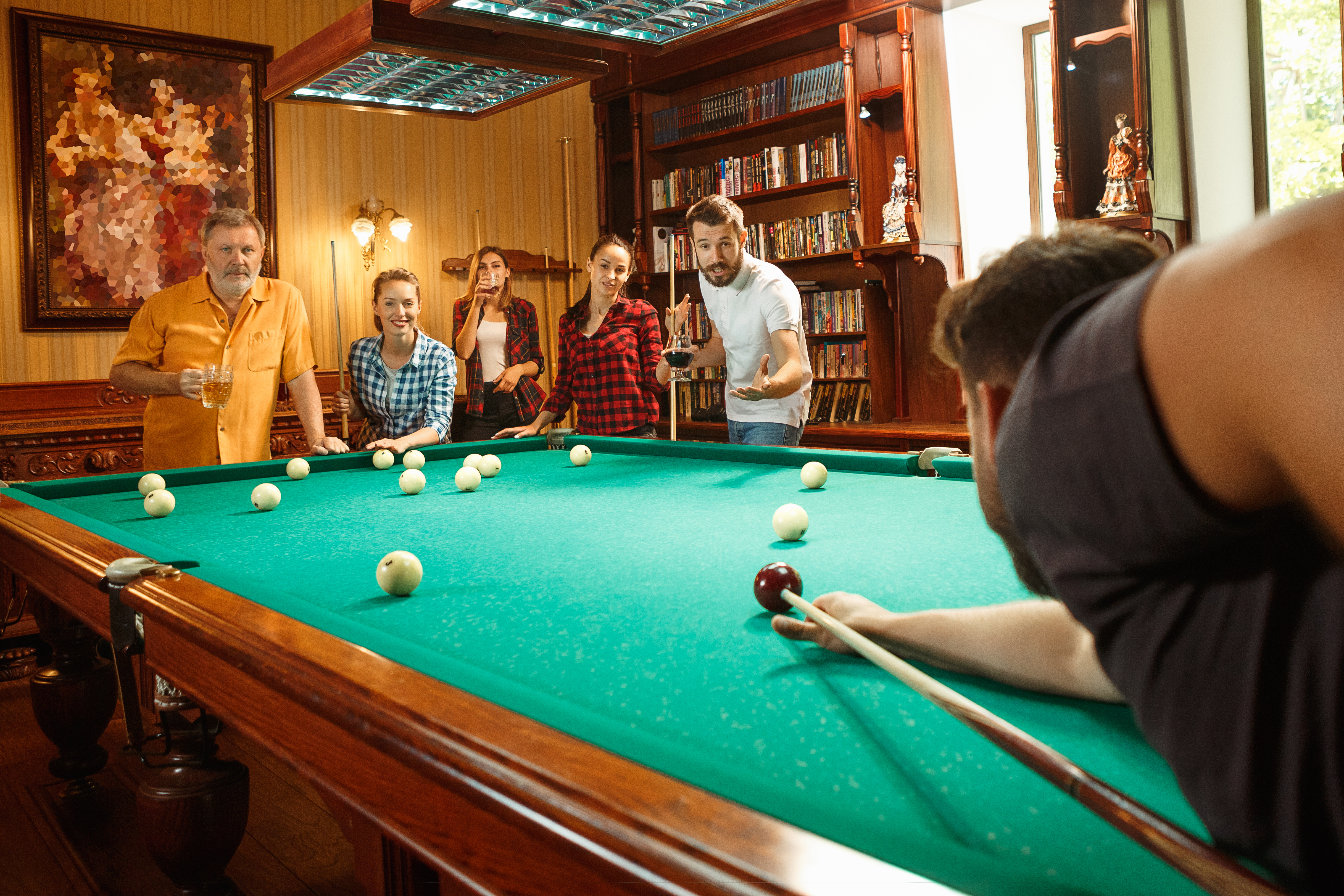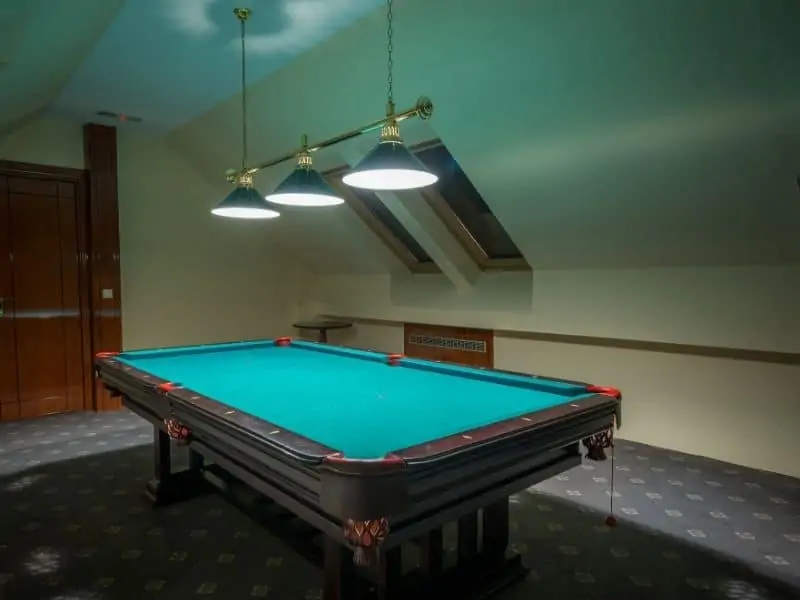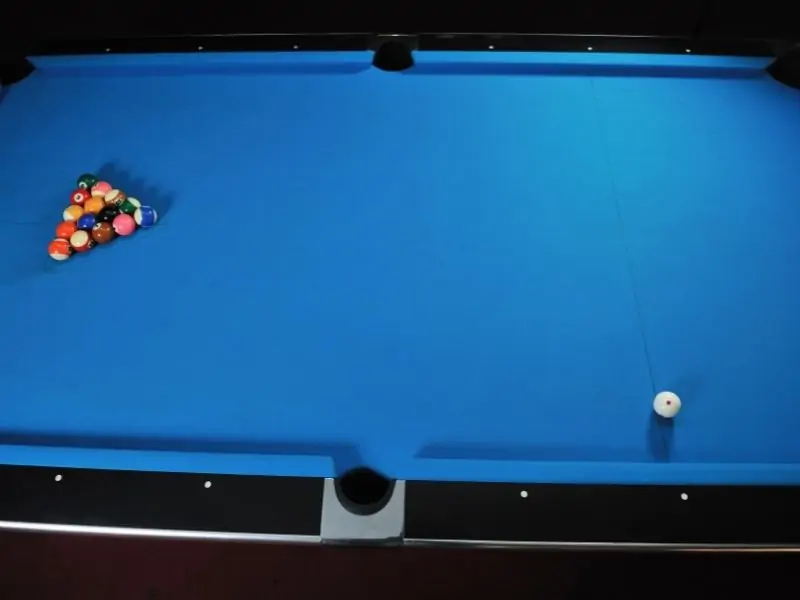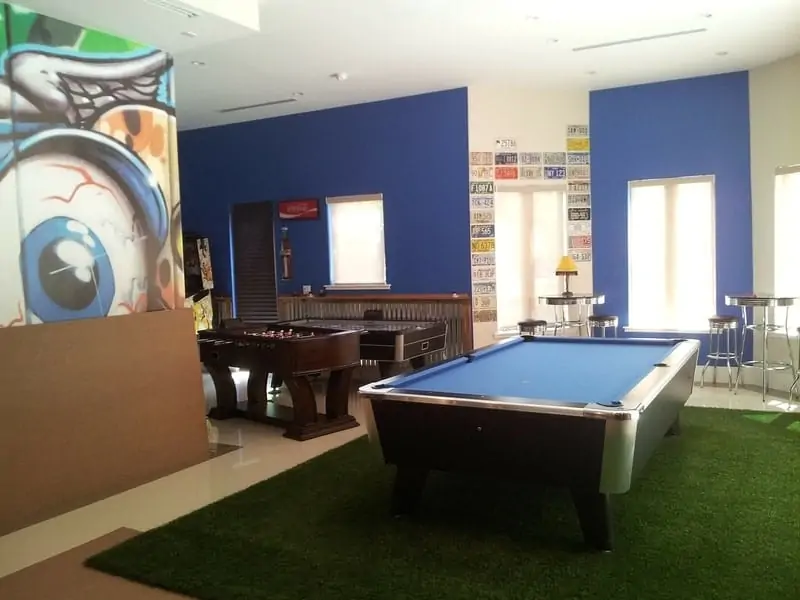If you’re new to the world of billiards, it may come as a surprise to you as to how many different billiard games there are. While its true that 8-Ball and 9-Ball are the most popular here in the states, there are lots of other billiard games that are just as much fun.
Pretty much every pool table game is similar in the way its played, but the the various rules, ball count, and techniques used can vary drastically. Take Bank Pool, for example, where every pocketed shot has to be a result of a bank shot. Learning different pool table games is a great way to improve your game and have a blast doing it.
If you’d like to mix up your current billiard mix, you’re in luck. In this article we’re going to share with 14 different billiard games you have to try. By the end of this article, you’ll know more pool table games than all of your pool hall buddies combined!
#1. 8 Ball
One of the most popular and well-known billiard games, 8 ball is played on a standard pool table with six pockets, usually measuring 4’ X 8’ or 3.5’ X 7’. Played by two people, this game is fairly straightforward, although there are lots of rule variations in practice around the world.
Racking and Breaking
To begin the game, you can flip a coin to determine who breaks. To determine who will be playing the solid balls, and who will be playing the stripes, one player must legally pocket one or more of the same suit on any shot after the break.
Stripes are the numbers 9 through 15, solids are 1 through 7. If either player legally pockets a ball of their own suit, they can go again until they miss or foul.
Playing and Winning 8 Ball Pool
The objective of 8-ball is to sink all of your object balls and then the 8-ball before your opponent does. Points are not typically assigned to the object balls, as is common in other pool table games. Instead, matches can be assigned points, or, as is more common, the winner can be crowned in “best out of 5 matches”, if you have the time.
Once all of the object balls of the player’s suit have all been pocketed, then that player can go for the 8-ball, calling the pocket beforehand. In order to win, a player must legally pocket the 8-ball in the called pocket, without scratching the cue ball.
Related Article:8-Ball Pool Rules: The Simple Version
#2. 9 Ball
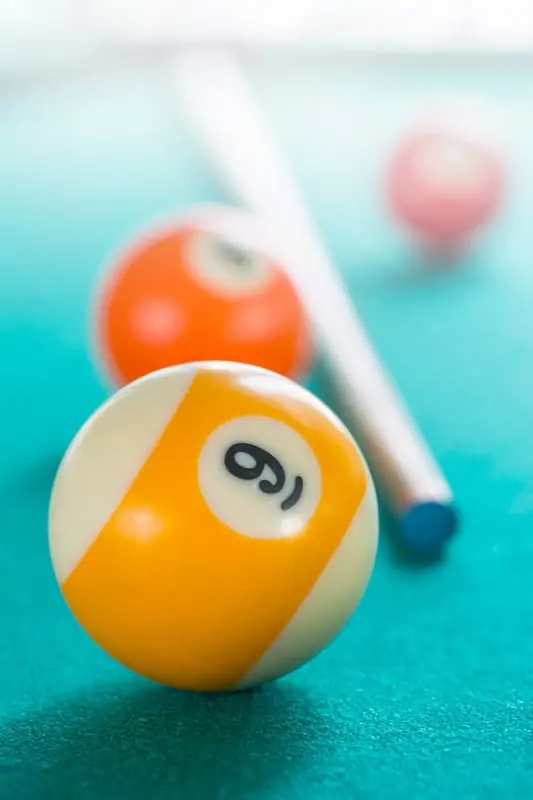
Next up is 9 Ball, which is arguably as popular as 8 Ball. As the name suggests, 9 Ball is played with 9 object balls (numbered 1 through 9) and a cue ball.
Racking and Breaking
The balls are racked in a diamond shape with the 1 ball at the apex on the foot spot and 9-ball in the middle. A legal break shot is one that drives at least four balls to a cushion, or pockets one or more balls— as long as the 1 ball is the first ball to be struck. If the cue ball is pocketed on the break, the opposing player takes over with ball in hand anywhere on the table.
Playing and Winning 9 Ball Pool
For the remainder of the game the players can pocket the balls in any order, as long as the first ball they hit with the cue ball is the lowest number on the table. The player who pockets the 9-ball first wins, whether done after the cue ball has hit the lowest numbered object ball on the table, or the 9-ball is the last ball in play.
Like in 8 Ball, any player who legally pockets a ball can continue to shoot until he/she misses, fouls, or wins the game. Since 9 Ball is a fairly quick game, many people play to a predetermined point threshold, assigning a point to each match or to each ball. Either way works.
#3. 10 Ball
10 Ball is very similar in its structure to 9 Ball, but with some big differences that make it a more difficult game. The game is played with 10 balls (numbered 1 through 10), racked in a triangle, instead of a diamond as in 9 Ball.
Racking and Breaking
The 1 ball should be at the apex and on the foot spot, and the 10 ball in the middle. The 2 and 3 balls should be placed one on each corner of the triangle. Like 9 Ball, on any given shot (including the break) the first contact must be made between the cue ball and the lowest numbered ball on the table.
Playing and Winning 10 Ball Pool
To make the game more difficult, the players must call the pocket and the ball which they plan to pot. The game can be won by pocketing the 10 ball at any point, as long as the cue ball first hits the lowest-numbered ball on the table, and the shot is called correctly.
If a player sinks a ball unintentionally or hits the called ball into the wrong pocket, the opposing player has the option to take over as the table is, or require the shooter to continue.
Any balls pocketed stay in the pocket, with the exception of the 10 ball. If a player sinks both an unintended ball and a called ball in a called pocket, he or she is allowed to continue. There are generally no points assigned to any of the balls, and a “best of” system is usually agreed upon in tournament-style play.
#4. 3 Ball
3 Ball is fairly unique in the pool game world. As the name implies, it is only played with 3 object balls and the cue ball. The major difference with this game is that a single rack is played by only one player. Once that player sinks all the balls— and tallies how many shots it took him or her— then it’s the other player’s turn.
For this reason, it’s possible to play 3 Ball with more than two people, but the more people who play, the longer the game will take, and the longer everyone will have to wait for their turn. However, with really skilled players, one rack is played very quickly.
Racking and Breaking
To rack the balls, simply use your normal triangle rack on the foot spot, like you would in 8 or 9 Ball. Use the balls numbered 1 through 3, with 1 at the apex on the foot spot, and the 2 and 3 balls behind the one, making up a small triangle. The break should be done with a cue ball in hand behind the head string.
Playing and Winning 3 Ball Billiards
The object of 3 Ball is to have the fewest number of shots at the end of the round. So, say you and a friend decide to play 3 rounds. The player with the fewest shots in 2 out of the 3 rounds would win. It is possible for two players of similar skill to keep tying in 3 Ball, at which point the solution is to play until one person wins.
Related Article: How to Play 3-Ball Pool: The Quickest Game In Billiards
#5. 7 Ball Pool
As far as billiard games go, 7 Ball is one of the best, most fast-paced games out there. This game is much like 9 Ball, but with a few key differences.
Racking and Breaking
7 Ball uses numbered balls 1 through 7 racked in a circle. This can easily be done with a diamond rack turned sideways on the foot spot. The 1 ball should be at the apex, balls 2 through 6 running clockwise in a circle from the 1, with the 7 ball in the middle.
In order for a break to be legal, the cue ball must hit the 1 ball first. If any ball is pocketed on the break, the player gets to continue shooting until a foul or miss occurs.
Playing and Winning 7 Ball
Once the break has been made, the non-breaking player chooses which long side of the table she will pocket the 7 ball in. The breaking player gets the other side of the table. The balls numbered 1 through 6 can be pocketed anywhere on the table, as long as the lowest numbered ball is hit first.
The player who legally pockets the 7 ball first wins the game. This means pocketing the ball on the previously decided side of the table. If a shooter pockets the 7 ball on the opponent’s side of the table, it’s a loss for the shooter. Normal foul rules apply to this billiard game, like scratching, pushing, and failing to hit an object ball.
7 Ball is often played as a training game because it teaches planning and strategy. It’s also tons of fun!
#6. Cut Throat Pool

For a great three-person billiard game, look no further than Cut Throat. This game uses all 15 balls, the cue ball, and a standard pool table. The easiest and most fair way to assign numbers is before the game.
Each player gets assigned ball groupings 1-5, 6-10, or 11-15. You can do this by a coin flip, rock-paper-scissors, overall agreement, or any other way that all three players agree upon.
Racking and Breaking
Rack the balls in the triangle, with the 1 ball at the apex on the foot spot, the 6 ball in one corner, and the 11 ball in the other. The rest of the balls can be in random order. Usually the 1-5 player breaks, followed by the other two players in ascending order.
Playing and Winning Cut Throat
You win the game by being the only player left with any balls still on the table. So, the object of the game is to sink your opponent’s balls. Players can continue to shoot until they fail to pocket an opponent’s ball, foul, scratch, or win the game. When a player’s last ball leaves the table, he can no longer play. Unless a foul is committed.
When a player fouls in Cut Throat, the other two players get to remove one of their balls from a pocket and place it on the pool table, bolstering their chances of staying in the game. Or, in the case of someone who was knocked out, they can get back in the game and shoot their turn while they still have at least one ball on the table.
Any balls replaced on the table should be put as close to the foot spot as possible without disturbing any balls currently in-play.
A foul is considered a scratch, knocking any ball off the table, pushing the cue ball, double-touching the cue ball, or moving balls on the table in any other way than a legal shot with the cue.
Being the last player standing is how to win the game, and chances are the other two players will be itching for a rematch!
Related Article: How To Play Cut Throat Pool: A Fun 3 Player Game
#7. Bank Pool
In Bank Pool, all shots must be called and can only be legally potted as a result of a bank shot. Meaning you can only pocket an object ball legally if you bounce it off one or more cushions. And you must call the cushions, the ball, and the pocket you intend to hit. This is what makes this pool table game such a challenge.
Racking and Breaking
Racking is pretty straightforward in Bank Pool. You use all 15 balls plus the cue ball. The object balls can be placed in the triangle in any random order. As in other games, the rack should be as tight as possible and placed at the foot spot on the table. Who breaks can be determined by a coin flip or any other agreed-upon method you see fit.
If you pocket a ball on the break, you can keep shooting but that ball doesn’t count and should be re-spotted after your inning is over, which we’ll discuss below.
Playing and Winning Bank Pool
Players can shoot until they miss a shot, scratch, foul, or win the game. Remember that all shots need to be called in full, from the ball number and the cushion to the pocket you’re aiming for. Any shot not called is considered illegal and any ball pocketed on illegal shots should be re-spotted at the foot spot of the table. Or, as close to it as possible.
Any and all of the object balls are in play and don’t need to be pocketed in any particular order. The player who sinks more object balls legally wins the game of Bank Pool. So, the first player to sink 8 out of the 15 balls on the table wins the game. Unless the player pocketed a ball unintentionally or illegally, at which point that ball or needs to be re-spotted immediately for play to continue.
Related Article: How To Play Bank Pool: Its So Much Fun
#8. Straight Pool
Straight Pool is a billiard game made famous by the movie_The Hustler._It’s still fairly popular in the US today, and is a fun and challenging billiard game.
Racking and Breaking
All 15 object balls are used in the rack, in no particular order. Like other games, the apex ball should rest on the foot spot, and the cue ball should be shot from behind the head string. A legal break is one that either pockets an object ball or sends the cue ball and two object balls to a cushion.
Playing and Winning Straight Pool
Straight Pool is played to a predetermined score. Usually this is 100 points, but it can be whatever the players agree upon initially. Each legally pocketed ball equals one point. Each foul is the loss of 1 point, unless a foul occurs on the break, then it means a loss of 2 points for the offending player. If a player fouls 3 times in a row, it means a loss of 15 points.
The object balls can be pocketed in any order, and each player shoots until they foul, scratch, or win the game. Since Straight Pool is continuous, once 14 balls have been pocketed the balls are re-racked and play continues. This re-rack is only done with the 14 pocketed balls, leaving the 15th object ball and the cue ball as they were.
The re-rack is done as it normally would be, but without the apex ball present. Once play continues, the shooting player tries to pocket the 15th object ball and hit the racked balls in one shot, in order to continue his or her run.
The first player to reach the predetermined score wins the game. Fouls in Straight Pool are much the same as in most other pool games. To make the game more challenging, you can employ a call-shot rule, meaning every shot has to be called in order to be legal. Either way you play, Straight Pool is lots of fun!
#9. One Pocket
The One Pocket pool table game limits each player to scoring in only one pocket at the foot of the table. This limits the playing surface significantly and makes for an interesting and challenging pool game.
Racking and Breaking
All 15 object balls should be racked in a triangle formation. There is no specific order that you need to rack the balls in, as there is no order they need to be shot during gameplay. The player determined to break (by coin flip, lag, or another method) can choose one of the two pockets at the foot end of the table. The other player is assigned the other pocket.
Any ball potted on the break in any pocket other than the one assigned to the shooter does not count and should be re-spotted at the end of the shooter’s inning. Re-spotted balls should be placed on or under the foot spot without interfering with the other balls in play.
Playing and Winning One Pocket
The first player to pocket 8 balls in their assigned pocket wins the game. Only balls pocketed legally in the assigned pocket count. However, if one player accidentally pockets a ball in her opponent’s pocket, the ball stays potted, the opponent gets a point, and gets to take over.
Any balls potted in any of the other pockets on the table should be re-spotted at the end of the player’s inning. A player can shoot at any ball, in any order, and can continue to shoot until he fouls, scratches, misses, or wins the game.
It’s easy to play with a handicap if the two players are unevenly matched. For instance, the more skilled player can be required to pocket 10 balls before the other player pockets 6. There are many different variations to One Pocket that can make the game very interesting and extremely fun!
#10. 15 Ball

One of the easiest billiard games to play is 15 Ball. You need all 15 object balls and a cue ball.
Racking and Breaking
The rack in 15 Ball is a standard triangle, but with the 15 ball at the apex and on the foot spot. The rest of the balls can be racked in random order. Which player breaks you can determine by a coin flip or a simple “you first”.
Playing and Winning 15 Ball
The game is won by the first player to reach 61 points. The number on each ball is the number of points the player will earn by pocketing that ball. A score of 61 points is just over half of the total points on all 15 balls.
So, you generally want to shoot for the highest-numbered ball first, as they will give you the most points. Unlike other pool games, the rules of 15 Ball are a little different. Each player gets one shot only. No matter if you miss or make the shot, the turn immediately goes to the next player. There is no running the table in 15 Ball.
Fouls result in the cue ball in hand behind the head string for the opposing player, and a loss of 3 points for the offending player. For balls pocketed along with a cue ball scratch, no points are awarded and the ball is re-spotted on the table.
That’s it! Pretty easy!
#11. Kelly Pool
Kelly Pool is a game that is usually played with the assistance of 15 peas, beads, or pills, numbered 1 through 15, to match the numbers on the pool balls. Each player receives one or more of the numbered beads, which are a way of assigning each player their “private number”. The object of the game is for each player to pocket their own secret number or numbers to win the game.
Racking and Breaking
All 15 object balls are racked in a triangle, with the 1 at the apex, the 2 in one lower corner, and the 3 in the other corner. All the other balls can be in random order. Determining the breaker is done by drawing straws, flipping a coin, or other means agreed upon by all the players.
Playing and Winning Kelly Pool
Each player is required to hit the lowest numbered ball on the table with the cue ball first. This is what makes the game interesting. If you’re able to pocket your secret number or numbers first, while striking the lowest numbered ball on the table first, you can win the game.
In some variations, the game continues with points given to those who pocket their secret balls. In this version, the first person to reach a predetermined point score wins the game. In most versions of Kelly Pool, there is no point deduction for a foul, just a loss of turn like in 8 or 9 ball.
There are lots of different ways to make Kelly Pool interesting! You can play for points and with up to 15 people!
#12. Chicago Pool (Rotation Billiards)
Chicago Pool is very similar to Kelly Pool in many ways, including the number of variations played around the US. It’s played with all 15 object balls and a cue ball.
Racking and Breaking
The rack in Chicago Pool is the same as in Kelly Pool, with the 1 ball at the apex, the 2 and 3 balls at the corners of the triangle, and the rest of the balls placed randomly. Determining who breaks can be determined in any number of ways that the players agree upon.
Playing and Winning Chicago Pool
Each player only gets one shot per turn, no matter if he or she pockets a ball or not. Like in Kelly Pool, each player must strike the lowest numbered ball on the table in order for their shot to be legal. But here’s the major difference in Chicago Pool: there are numerous “money balls” that have been assigned money before the game.
Whatever player pockets a money ball gets to keep the money set aside before the game for that particular ball. The game is won by the first player to reach 61 points, as denoted by the numbers on the balls.
The number of money balls should be agreed upon beforehand, with all players contributing equal shares to the pot.
#13. Bowlliards
Although the name may look a little awkward, the game of Bowlliards is lots of fun— even for only one player! It’s bowling— but on a pool table.
Rack and Break
Ten balls of any number should be racked in a triangle formation, with the apex ball on the foot spot. Each player gets to play 10 “frames” which means that each player gets a “free break” on their turn. A free break means that there are no rules about the number of balls hitting cushions or becoming pocketed for the player to continue.
Playing and Winning Bowlliards
Once the player has had his free break, he continues to try and pocket all 10 balls on the table. Just like in bowling, a player gets two chances to pocket all ten balls without scratching or missing a shot. But, the shots must be accurately called to be legal.
If she does it on her first try, meaning she pockets all ten without missing a shot or scratching, it’s considered a strike. If it takes her two turns to pocket all the balls, it’s a spare. If there are balls left on the table after the two turns, she only gets one point per pocketed ball. The game goes on for 10 frames, the winner being the player with the highest score at the end.
#14. Baseball Pocket Billiards

Baseball Pocket Billiards is named as such because of the 9 “innings” that each player is allowed before the final score is tallied and the game ends. This game requires 21 object balls and a cue ball to play.
Racking and Breaking
Sets of 21 balls and oversize triangle racks are sold expressly for playing Baseball Billiards. The 1 ball should be at the apex of the triangle, with the 2 and 3 balls at each bottom corner. The 9 ball should be in the middle of the rack, much like the 8 ball would be in 8-ball pool.
The rotation of play can be determined by coin flips or lags. Each player gets their own break at the start of their 9-inning “visit”. Any balls pocketed on the break are scored according to their ball number.
Playing and Winning Baseball Pocket Billiards
After their break, each player must call shots. If a player misses a called shot, or fouls in any other way outlined by standard pool rules, that inning is over and any pocketed balls are recorded as his score for the inning. A scratch means an automatic end to— and a zero for— that inning. Each player gets nine innings and whoever has the most points at the end of the game wins. If you’re a fan of baseball and pool, this game is for you!
In Conclusion
As you can see, there are lots of different billiard games out there, all of which are super fun and a blast to enjoy with friends. Next time you’re at the pool hall, be sure to give a few of them a try.
Playing different pool table games is a great way to mix things up. After all, playing 8-Ball or 9-Ball over and over again gets repetitive very fast. Don’t bore yourself to death with the same ol’ games when there are so many more to try! Share these games with your friends! Im sure they”ll enjoy them just as much as I do. Thanks for reading!
Other Articles You May Be Interested In:
- Best Pool Cues for the Money: Discover the top pool cues that offer great value without breaking the bank.
- Pool Table in the Garage? Here’s What You Need to Know: Understand the essential considerations for setting up a pool table in your garage.
- Break Cue vs Playing Cue: What’s the Difference?: Learn the key differences between break cues and playing cues to enhance your game.
- How Much Does a Good Pool Cue Cost?: Explore the factors that determine the cost of a high-quality pool cue.
- Are Mini Pool Tables Worth It? A Complete Guide: Read our comprehensive guide on mini pool tables and decide if they’re the right fit for you.
